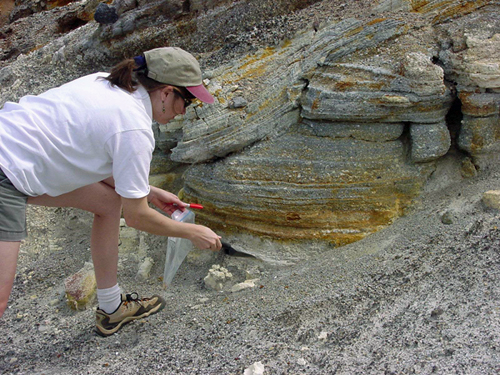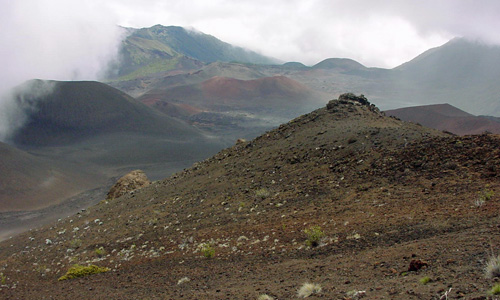By Dr. Janice Bishop; Carl Sagan Center for the Study of Life in the Universe, SETI Institute, and Gail Jacobs
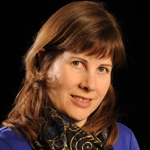 Dr. Janice Bishop is a chemist and planetary scientist who explores the planet Mars using spectroscopy. Her investigations of CRISM data of Mars are revealing clays and sulfates in the ancient rocks that provide information about the geochemical environment at that time. Dr. Bishop studies the spectral fingerprints of minerals and rocks in the lab in order to generate a spectral library for identification of these in the Martian data. Her research also involves collecting and studying Mars analog rocks and soils at a variety of locations including volcanic islands, cold deserts, hydrothermal regions, acidic aqueous sites, and meteorites which are the only Martian samples available on Earth to date.
Dr. Janice Bishop is a chemist and planetary scientist who explores the planet Mars using spectroscopy. Her investigations of CRISM data of Mars are revealing clays and sulfates in the ancient rocks that provide information about the geochemical environment at that time. Dr. Bishop studies the spectral fingerprints of minerals and rocks in the lab in order to generate a spectral library for identification of these in the Martian data. Her research also involves collecting and studying Mars analog rocks and soils at a variety of locations including volcanic islands, cold deserts, hydrothermal regions, acidic aqueous sites, and meteorites which are the only Martian samples available on Earth to date.
Click on images for larger view
What first sparked your interest in science?
I grew up in Livermore, California. My Mom is a scientist and my dad is an engineer, so I was always exposed to science. Livermore is a town with an abundance of scientists, ranchers, and wineries, so being a scientist was a very normal career path.
When I was a kid my parents brought my brother and I to science fairs and open houses at the Lawrence Livermore and Lawrence Berkeley Laboratories. We saw the cool things the scientists were doing and became interested ourselves. These open houses were similar to the SETI Institute's Celebrating Science event, and I am glad to see the SETI Institute hosting these types of public events as well. You never know what will capture the imagination and interest of a child.
Very briefly, describe your research project. 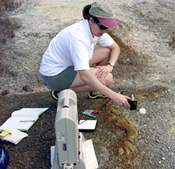 I currently have several ongoing projects, which all primarily relate to mineralogy on Mars. We are trying to identify the ancient rocks on the planet - rocks that contain clays, sulfates and other minerals that formed under aqueous conditions. These findings will allow us to look for areas where water might have been present on the planet and where life might have been a possibility. The photo to the left shows Dr. Bishop measuring spectra of sulfate-rich rocks at the Sulfur Bench site at Kilauea, Hawaii. Credit: L. Gruendler.
I currently have several ongoing projects, which all primarily relate to mineralogy on Mars. We are trying to identify the ancient rocks on the planet - rocks that contain clays, sulfates and other minerals that formed under aqueous conditions. These findings will allow us to look for areas where water might have been present on the planet and where life might have been a possibility. The photo to the left shows Dr. Bishop measuring spectra of sulfate-rich rocks at the Sulfur Bench site at Kilauea, Hawaii. Credit: L. Gruendler.
Tell us a bit about the technology that enables your research.
We use information captured by the Mars Reconnaissance Orbiter, which is still flying in orbit around Mars. It launched in 2005 and started collecting data October 2006. CRISM (Compact Reconnaissance Imaging Spectrometer for Mars) is a hyperspectral imaging camera that is on board. Instead of the three colors our eyes use to perceive our world, CRISM gives us 544 channels. We use all these different colors to view the planet. We are looking at these Martian images in order to identify the mineralogy, and the mineralogy tells us about the geochemical environment on the planet.
Minerals have a unique signature that is like a fingerprint. They show up as small peaks and dips in the spectrum. By looking for these dips, peaks and curves, we can identify minerals on the planet. In order to identify minerals on Mars, however, we need to study minerals in the lab and at field locations analogous to Mars, which are two other projects of mine. I analyze the data sent back from CRISM along with other members of the CRISM Team and the scientific community.
What is one of the coolest things about your projects?
We are finding many of these clays in the really ancient rocks. It's like having access to this clear window back into time on the planet Mars. We do not have that option for Earth because our planet has been "contaminated" by life. Our planet is a host to all types of plants and animals that have changed the planet substantially in the past 4 billion years. But on Mars, the clay minerals in particular can tell us a lot about the geochemical environment 4 billion years ago; and that helps us understand what the planet was like then and if life might have evolved. Whether life did or did not evolve is interesting and helps us further understand evolution of life on our planet Earth, and that is pretty cool.
Dr. Bishop collecting samples from the solfatara site inside Kilauea caldera, Hawaii. The volcanic ash has been altered here by the steam vents. Orange layers are colored by jarosite, an iron-rich sulfate mineral. Light-colored layers contain opal. Credit: L. Gruendler
What do you currently consider your biggest challenge?
There are so many! Getting good spectral libraries is a challenge. When we are looking at these spectra, or the curves, dips, slopes and peaks from Mars, we want to be able to identify them as a specific type of mineral or rock.
Mars may have other kinds of rocks or minerals in a form different from those on Earth or types that are less common on Earth. As we collect and analyze this data, we try to identify certain aspects as belonging to a class of minerals, such as clays, sulfate or mafic silicates. As we study these images in more detail, we then try to find analogs of the mineral combinations or rock types in nature so that we can infer the geochemical environment on Mars. It is important to collect as many samples as we can on Earth so we can continue to build and expand our library. Beyond looking at the pure minerals, we also try to look at the alteration of igneous rocks to see how the minerals we are interested in form in situ.
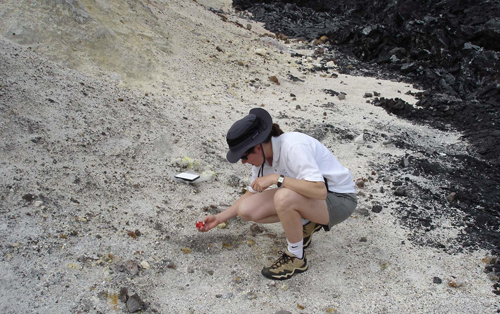
Dr. Bishop testing magnetic properties of soil at the solfatara site inside Kilauea caldera, Hawaii. Credit: E. Goeschl
Where are some of the places your field work takes you?
There are several locations on Earth that serve as Mars analogs. Mostly, we try to go to remote places where there is less vegetation and fewer human interactions. Dry areas are good, and some scientists go to the Atacama or the Antarctic Dry Valleys. My field research has mainly taken me to Hawaii and other volcanic islands such as Iceland. I have frequently been to the top of Haleakala on Maui because there is less vegetation. Other interesting sites are near Kilauea on the Big Island. I like to study alteration of the volcanic rocks in order to study the kinds of minerals that form under different environmental conditions. The National Park Service has been very helpful providing us with field permits; sometimes they even join us with our field work.
View of cinder cones inside the Haleakala caldera from Sliding Sands Trail, Maui. Credit: J. Bishop
It's fun to climb up these volcanoes and look at the different forms and colors of the rocks. Often the iron in the minerals is an indicator because it produces different colors depending on the mineral structure. At Haleakala much of the altered volcanic rocks are a shade of brown but the ones near cinder cones or those with some interesting mineralogy can be orange, purple, pink, yellow or other colors because of their iron content.
Why should the general public care about your research? 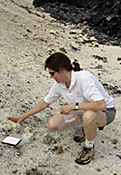 A lot of people are curious about Earth's evolutionary process. One of the big reasons we might care about how life evolved on Mars is because this information could help reveal more about our own planet. We hope to learn how those minerals on Mars formed and whether or not life evolved. Studying the clays and understanding how Mars' early geochemical environment changed will help tell us whether or not there was life there and how it might have evolved. And that information can help us better understand how life might have evolved here on Earth. You can see Dr. Bishop collecting samples at the solfatara site inside Kilauea caldera, Hawaii, in the the photo to the right. Credit: E. Goeschl.
A lot of people are curious about Earth's evolutionary process. One of the big reasons we might care about how life evolved on Mars is because this information could help reveal more about our own planet. We hope to learn how those minerals on Mars formed and whether or not life evolved. Studying the clays and understanding how Mars' early geochemical environment changed will help tell us whether or not there was life there and how it might have evolved. And that information can help us better understand how life might have evolved here on Earth. You can see Dr. Bishop collecting samples at the solfatara site inside Kilauea caldera, Hawaii, in the the photo to the right. Credit: E. Goeschl.
How did you come to join the SETI Institute?
Through much of my undergraduate years at Stanford, I worked on projects through NASA Ames. In grad school, I also received a NASA Graduate Student Researcher's Program Fellowship through NASA Ames. I did my post-doc at the DLR in Germany for two years, and then came back to Ames for an NRC research fellowship. At that time I started meeting people at the SETI Institute and it seemed like a great place with which to become involved. I joined the Institute in March 1999.
What motivates you?
I love what I do! I love my projects. I don't really ever put them away; they are always traveling with me. Occasionally I'll wake up at night with a great idea, then write it down and go back to sleep. Often I get an idea while I'm listening to a lecture or waiting for an appointment -- the ideas always bubble up. The thoughts are always there and the projects are always working in the back of my mind. It is just a part of my life.
What was your dream job as a child?
I wanted to be an astronaut. I imagine a lot of people thought about that career. I actually applied when I was finishing graduate school. I interviewed twice but was not selected due to a depth perception problem with my vision. But it was so cool to go through the interview process and find out about the astronaut program, what they do and all the bizarre medical tests they put you through.
As a youth, did you have any experiences that influenced your career?
When I was 16 and in high school, I went to a summer camp on astronomy called SSP (Summer Science Program). The NSF (National Science Foundation) used to sponsor these camps, and I was among 36 kids from around the country that participated in this program. It was a great experience to spend six weeks hanging out with other kids interested in astronomy and learning a lot about science. Our project was to observe an asteroid with a telescope and calculate its orbit. For me, it was a real eye opener that I could do this. SSP still exists today and is largely sponsored by the alumni. Unfortunately, NSF stopped support of all of these extracurricular high school programs years ago.
If you were speaking to a group of teens about your career, what would you tell them?
I would tell them they need to find something that really interests them and that they are passionate about. Find something you want to spend all of your free time doing. And study hard, work hard, and learn a lot. You have to persevere. Things don't always work out well on the first try. There are going to be ups and downs in anything. If you have a bad day, you just have to take a deep breath, go get an ice cream, and come back the next day and try again.
What historic and/or contemporary personality do you admire most and why?
I admire Marie Curie and Amelia Earhart because they were outstanding women who did interesting work. I also admire Lise Meitner. She was a physicist in Berlin in the early 1900s and I learned about her when I lived there. Both Dr. Curie and Dr. Meitner were important scientists who contributed greatly toward our understanding of chemistry and physics, and had to overcome a number of challenges in their lives.
What is your favorite vacation destination?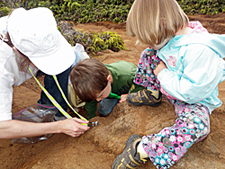 We have a lot of fun collecting rocks when we go to Hawaii or Iceland. There is so much for families to do in the Hawaiian Islands, so my husband can take the kids to the beach while I go hiking to look at the rocks. Sometimes we all go hiking together and our kids are very interested in exploring as well. Sometimes I bring a magnet or a couple of magnifying glasses because the kids enjoy studying the rocks too. Dr. Bishop with her kids examining altered volcanic rocks in the field in the photo to the right. Credit: L. Gruendler.
We have a lot of fun collecting rocks when we go to Hawaii or Iceland. There is so much for families to do in the Hawaiian Islands, so my husband can take the kids to the beach while I go hiking to look at the rocks. Sometimes we all go hiking together and our kids are very interested in exploring as well. Sometimes I bring a magnet or a couple of magnifying glasses because the kids enjoy studying the rocks too. Dr. Bishop with her kids examining altered volcanic rocks in the field in the photo to the right. Credit: L. Gruendler.
If you had a one-year sabbatical to learn something entirely new, what would it be?
I always wanted to go to Egypt. I think the archeology there is just fascinating. It would be so interesting to be an archeologist in Egypt for a year.
Learn more about Janice and her interesting research in her full interview.
